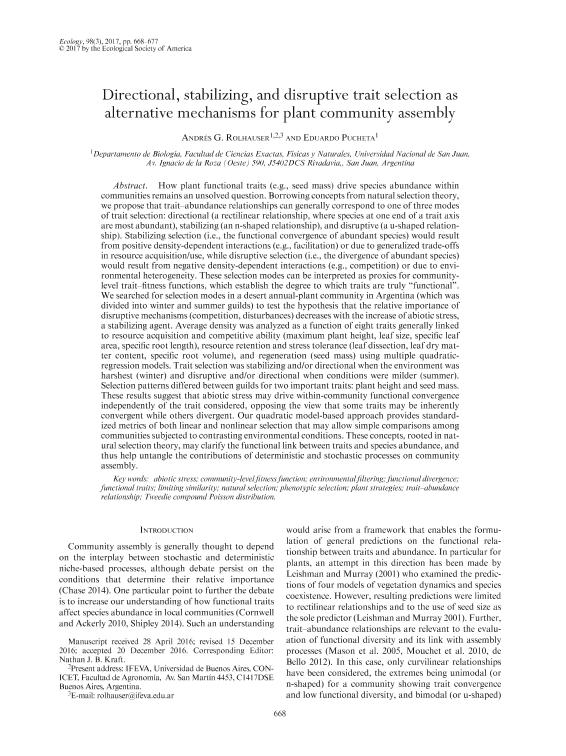Artículo
Directional, stabilizing, and disruptive trait selection as alternative mechanisms for plant community assembly
Fecha de publicación:
30/03/2017
Editorial:
Ecological Society of America
Revista:
Ecology
ISSN:
0012-9658
Idioma:
Inglés
Tipo de recurso:
Artículo publicado
Clasificación temática:
Resumen
How plant functional traits (e.g., seed mass) drive species abundance within communities remains an unsolved question. Borrowing concepts from natural selection theory, we propose that trait-abundance relationships can generally correspond to one of three modes of trait selection: directional (a rectilinear relationship, where species at one end of a trait axis are most abundant), stabilizing (an n-shaped relationship), and disruptive (a u-shaped relationship). Stabilizing selection (i.e., the functional convergence of abundant species) would result from positive density-dependent interactions (e.g., facilitation) or due to generalized trade-offs in resource acquisition/use, while disruptive selection (i.e., the divergence of abundant species) would result from negative density-dependent interactions (e.g., competition) or due to environmental heterogeneity. These selection modes can be interpreted as proxies for community-level trait-fitness functions, which establish the degree to which traits are truly "functional". We searched for selection modes in a desert annual-plant community in Argentina (which was divided into winter and summer guilds) to test the hypothesis that the relative importance of disruptive mechanisms (competition, disturbances) decreases with the increase of abiotic stress, a stabilizing agent. Average density was analyzed as a function of eight traits generally linked to resource acquisition and competitive ability (maximum plant height, leaf size, specific leaf area, specific root length), resource retention and stress tolerance (leaf dissection, leaf dry matter content, specific root volume), and regeneration (seed mass) using multiple quadratic-regression models. Trait selection was stabilizing and/or directional when the environment was harshest (winter) and disruptive and/or directional when conditions were milder (summer). Selection patterns differed between guilds for two important traits: plant height and seed mass. These results suggest that abiotic stress may drive within-community functional convergence independently of the trait considered, opposing the view that some traits may be inherently convergent while others divergent. Our quadratic model-based approach provides standardized metrics of both linear and nonlinear selection that may allow simple comparisons among communities subjected to contrasting environmental conditions. These concepts, rooted in natural selection theory, may clarify the functional link between traits and species abundance, and thus help untangle the contributions of deterministic and stochastic processes on community assembly.
Archivos asociados
Licencia
Identificadores
Colecciones
Articulos(IFEVA)
Articulos de INST.D/INV.FISIOLOGICAS Y ECO.VINCULADAS A L/AGRIC
Articulos de INST.D/INV.FISIOLOGICAS Y ECO.VINCULADAS A L/AGRIC
Citación
Rolhauser, Andrés Guillermo; Pucheta, Eduardo Raúl; Directional, stabilizing, and disruptive trait selection as alternative mechanisms for plant community assembly; Ecological Society of America; Ecology; 98; 3; 30-3-2017; 668-677
Compartir
Altmétricas




